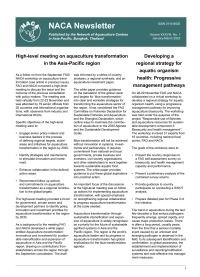Hilsa are a highly favoured food fish on the Indian subcontinent, but wild populations have been declining very fast due to over exploitation and disturbance of their riverine spawning grounds. Hilsa have a complex life cycle, migrating from the sea to riverine environments to spawn and are very sensitive to handling, which has complicated efforts to breed them in captivity. The ICAR-Central Institute of Freshwater Aquaculture has initiated a programme to domesticate hilsa to reduce dependence on wild catch. This article documents the first successful approaches to rear larvae through to table sized fish and to develop mature hilsa broodstock in a farm environment.
Today, tribal people comprise 8.6 percent of the Indian population and are one of the most disadvantaged sections of society. Many tribal groups in different parts of the country depend on natural resources for their livelihoods, to which their access has been progressively eroded. With financial support from ICAR-CIFT the College of Fisheries, Gumla, undertook seven training programmes for tribal women from economically marginalised tribal communities in the preparation and marketing of value-added fisheries products. The training encouraged women to develop small businesses building on their micro-entrepreneurship.
With the implementation of the new aquatic animal disease reporting in the Asia Pacific region from January 2021, and in lieu of the published QAAD Reports (last issue published was 4th quarter of 2020), NACA is publishing reported aquatic animal diseases submitted by countries in the Asia-Pacific region. This report covers the third quarter of 2022 and the original and updated reports can be accessed at the QAAD page.
NACA now has a custom YouTube handle to make it easier to visit our channel, "@aquacultureasia". Thanks to our subscribers for signing up and making this possible! You can find us anytime by visiting:
In this issue:
High-level meeting on aquaculture transformation in the Asia-Pacific region; Developing a regional strategy for aquatic organism health: Progressive management pathways; Job opportunity - health management and husbandry researcher; 2022 China-ASEAN International Forum on Sustainable Development of Fisheries and Aquaculture Under the Blue Transformation Strategy; A new progressive management pathway for improving seaweed biosecurity; Indian delegates visit Thailand for training and industry exposure; PhD scholarships: Shanghai Ocean University PhD Programme 2023; Reported aquatic animal diseases in the Asia-Pacific region during the second quarter of 2022.



